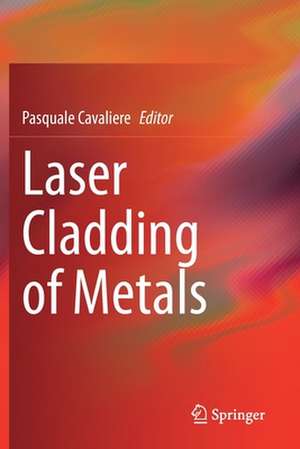Laser Cladding of Metals
Editat de Pasquale Cavaliereen Limba Engleză Paperback – 7 noi 2021
The wide range of materials that can be deposited and its suitability for treating small areas make laser cladding particularly appropriate to tailor surface properties to local service requirements and it opens up a new perspective for surface engineered materials. The main key aspect to be scientifically and technologically explored are the type of laser; the powders properties; the processing parameters; the consequent microstructural and mechanical properties of the processed material; the capability of fabrication of prototypes to rapid tooling and rapid manufacturing.
- Distills critical concepts, methods, and applications from leading full-lengthchapters, along with the authors’s own deep understanding of the material taught, into a concise yet rigorous graduate and advanced undergraduate text;
- Reinforces concepts covered with detailed solutions to illuminating and challenging industrial applications;
- Discusses current and future applications of laser cladding in additive manufacturing.
| Toate formatele și edițiile | Preț | Express |
|---|---|---|
| Paperback (1) | 788.72 lei 43-57 zile | |
| Springer International Publishing – 7 noi 2021 | 788.72 lei 43-57 zile | |
| Hardback (1) | 945.32 lei 38-44 zile | |
| Springer International Publishing – 6 noi 2020 | 945.32 lei 38-44 zile |
Preț: 788.72 lei
Preț vechi: 961.85 lei
-18% Nou
Puncte Express: 1183
Preț estimativ în valută:
150.97€ • 164.04$ • 126.90£
150.97€ • 164.04$ • 126.90£
Carte tipărită la comandă
Livrare economică 21 aprilie-05 mai
Preluare comenzi: 021 569.72.76
Specificații
ISBN-13: 9783030531973
ISBN-10: 303053197X
Ilustrații: XI, 441 p. 244 illus., 158 illus. in color.
Dimensiuni: 155 x 235 mm
Greutate: 0.64 kg
Ediția:1st ed. 2021
Editura: Springer International Publishing
Colecția Springer
Locul publicării:Cham, Switzerland
ISBN-10: 303053197X
Ilustrații: XI, 441 p. 244 illus., 158 illus. in color.
Dimensiuni: 155 x 235 mm
Greutate: 0.64 kg
Ediția:1st ed. 2021
Editura: Springer International Publishing
Colecția Springer
Locul publicării:Cham, Switzerland
Cuprins
Introduction.- Laser cladding processing fundamentals.- Laser cladding process modelling.- Laser cladding additive manufacturing.- Laser cladding aerospace applications.- Laser cladding of Ni-based superalloys.- Laser cladding of Al alloys.- Laser cladding of Ti alloys.- Laser cladding of Iron based alloys.- Laser cladding of metal matrix composites.- Laser cladding of Co alloys.- Laser cladding of metallic glasses.- Laser cladding of High entropy alloys.
Notă biografică
Pasaquale Cavaliere is an Associate Professor at the University of Salento in Italy. He received his PhD from the University of Rome. He has served as the Marie Curie Fellow at the Massachusetts Institute of Technology’s Materials Science and Engineering Department. He is the author of over 200 papers, which have garnered over 2000 citations.
Textul de pe ultima copertă
Laser cladding is an additive manufacturing technology capable of producing coatings due to the surface fusion of metals. The selected powder is fed into a focused laser beam to be melted and deposited as coating. This allows to apply material in a selected way onto those required sections of complex components. The process main properties are the production of a perfect metallurgically bonded and fully dense coatings; the minimal heat affected zone and low dilution between the substrate and filler material resulting in functional coatings that perform at reduced thickness, so fewer layers are applied; fine, homogeneous microstructure resulting from the rapid solidification rate that promotes wear resistance of carbide coatings; near net-shape weld build-up requires little finishing effort; extended weldability of sensitive materials like carbon-rich steels or nickel-based superalloys that are difficult or even impossible to weld using conventional welding processes; post-weld heat treatment is often eliminated as the small heat affected zone minimizes component stress; excellent process stability and reproducibility because it is numerical controlled welding process. The typical applications are the dimensional restoration; the wear and corrosion protection; additive manufacturing.
The wide range of materials that can be deposited and its suitability for treating small areas make laser cladding particularly appropriate to tailor surface properties to local service requirements and it opens up a new perspective for surface engineered materials. The main key aspect to be scientifically and technologically explored are the type of laser; the powders properties; the processing parameters; the consequent microstructural and mechanical properties of the processed material; the capability of fabrication of prototypes to rapid tooling and rapid manufacturing.
- Distills critical concepts, methods, and applications from leading full-length chapters, alongwith the authors’s own deep understanding of the material taught, into a concise yet rigorous graduate and advanced undergraduate text;
- Reinforces concepts covered with detailed solutions to illuminating and challenging industrial applications;
- Discusses current and future applications of laser cladding in additive manufacturing.
Caracteristici
Distills critical concepts, methods, and applications from leading full-length chapters, along with the authors’s own deep understanding of the material taught, into a concise yet rigorous graduate and advanced undergraduate text Reinforces concepts covered with detailed solutions to illuminating and challenging industrial applications Discusses current and future applications of laser cladding in additive manufacturing
